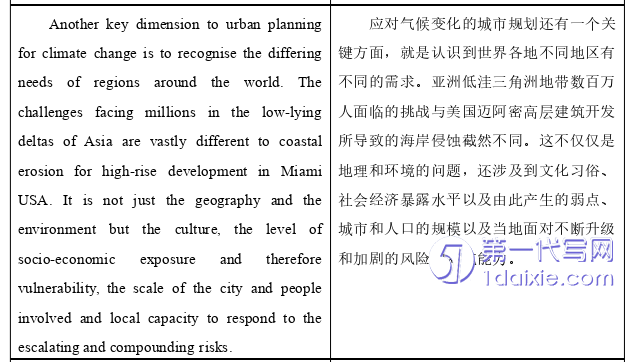本文是一篇英语毕业论文,本篇翻译实践报告的原文本属于学术类文本,具有用词严谨、表述准确、逻辑严密的特点。
Chapter One Task Description
1.1 Background Information of the Translation Task
With the development of the global economy,rapid urbanization and climate changehave brought new challenges——frequent natural disasters and increasingly prominentecological and environmental issues.In recent years,affected by extreme climate,manyregions in the world have faced catastrophic fires,rare high-temperature weather,recordrainfall and other problems.It is urgent to deal with the global challenges brought by theclimate crisis.This requires all the countries not only to set clear goals but also to turn theminto effective policies,detailed plans and tangible actions.Climate change is not only anenvironmental issue,but also a problem of urban development.As one of the important waysto guide urban development,urban planning should actively guide the city to change itsdevelopment mode through its own innovation,so as to alleviate and resist the damagecaused by the climate crisis.The traditional urban planning theory can no longer meet theneeds of urban development in today’s society,so it is necessary to find new concepts forcities to address and adapt to climate change.
The original text of this practice report is Urban Planning for Climate Change.Thebook states the climate change and crisis facing the world at present,the impact of thesechanges and crisis on urban planning,and the adjustments and changes that should be madein future urban planning on climate issues.

1.2 Translation Process
The process of a translation task can be divided into pre-translation,mid-translation andpost-translation.The relationship between each stage is very close and complementary.Translators should complete corresponding work and tasks at each stage to ensure translationto be efficient and smooth.
1.2.1 Pre-translation
Before the translation begins,the translator should make corresponding preparations.Firstly,the translator read through the original text and gained a comprehensiveunderstanding of its meaning.Also,the translator summarizes the language and text featuresthat appear frequently in the original text,in order to be close to the style of the original textin translation.Secondly,the translator has chosen appropriate translation assistance tools.When encountering words or phrases with uncertain meanings during the translation process,the translator uses paper dictionaries(such as Oxford Dictionary and Collins Dictionary)oronline translation software(such as Google Translate,Baidu Translate,and DeepL)to search.The translator also searched for parallel text related to urban planning and climate change tobroaden knowledge and draw on the expertise and expression.Finally,the translatorformulated a detailed translation schedule,which stipulated a daily translation volume of approximately 1,000 words based on translation ability and efficiency,to complete thetranslation task on time.
Chapter Two Source Text Analysis
2.1 Content of the Source Text
The original text is selected from the second chapter of the book Urban Planning forClimate Change and was published in 2022.The author is Barbara Norman,who is thedirector of Canberra Urban and Regional Futures and an adjunct professor at the AustralianNational University.Professor Norman is a life fellow and past national president of thePlanning Institute of Australia and a life honorary fellow of the Royal Town PlanningInstitute(United Kingdom).This book tackles the future challenges and opportunities forplanning our cities and towns in a changing climate,and recommends key actions for moreresilient urban futures.Urban Planning for Climate Change focuses on how urban planningis fundamental to action on climate change.In doing so it particularly looks at currentpractices and opportunities for innovation and capacity building in the future-carbon-neutraldevelopment,building back better and creating more resilient urban settlements around theworld.Norman recommends ten essential actions for urban planning for climate change,along with some suggestions to inspire the next generations to embrace these opportunitieswith creativity and innovation.In Chapter 2,the author analyzes the present and futureopportunities and challenges at the global,regional,and national levels,and providescorresponding suggestions.
2.2 Features of the Source Text
As an academic work,the original text belongs to the category of information text.Theoriginal text with professional content and rigorous logic covers many fields related toclimate,environmental protection,and urban construction.
The frequent occurrence of nominalized words in the text is characterized by concisewords,compact structures and objective expression,which conforms to the linguisticfeatures of academic texts.However,due to the differences in the expression habits betweenEnglish and Chinese,Chinese uses more verbs and adjectives,and rarely uses nominalizedwords.Therefore,if some vocabulary is translated directly,it may cause the translation to beunclear and the target readers may not understand.
The original text also uses a large number of long sentences and passive sentences.Long sentences are a difficult problem in English-Chinese translation,with complex structures and a large amount of information.In English,multi-level long sentences arecommonly used,while in Chinese,short sentences are often used.If long sentences in theoriginal text are not handled properly,it can also affect the logic and smoothness of thetranslation.
Chapter Three Problems and Solutions ................................. 8
3.1 Translation of Nominalized Words ..................... 8
3.1.1 Conversion ................................... 8
3.1.2 Amplification............................... 10
Conclusion .......................... 19
Chapter Three Problems and Solutions
3.1 Translation of Nominalized Words

The frequent appearance of nominalized words is one of the characteristics of academictexts.Because academic texts are rigorous in wording,concise in writing,accurate inexpression,logically rigorous,and emphasize existing facts rather than specific actions.Nominalization can make sentences concise,objective and formal,and can express themeaning accurately,clearly and concisely.Nominalized words are widely used in Englishtexts to make the structure more concise,the expression more rigorous and formal.LiBingwu and Yan Jingmin(2002:5-7)pointed out that the nominalization structure contains alarge number of nouns and noun phrases,that is,in everyday English texts or texts withother functions and themes,verbs,adjectives and other parts of speech act as certaingrammatical elements,while in information texts,nouns often act as such grammaticalelements.The original text belongs to the category of information text.To reflect itsobjectivity,the author frequently uses nominalized words.
3.1.1 Conversion
The purpose of translation is to achieve equivalence in information content betweentwo languages,rather than pursuing complete formal similarity.Therefore,in translation,translators often use conversion to achieve consistency in content and information throughformal deviation.(Luo Hongxia,2015:113-116)By converting the parts of speech of certainwords in the original text,such as English nouns into Chinese verbs,the translation can beaccurate and fluent.Therefore,in dealing with the problems of translating nominalizedwords,the method of conversion is often used.
Conclusion
Based on the content of Chapter 2 of the book Urban Planning for Climate Change,this report first introduces the translation background and process,and then summarizes thecontent and the language characteristics of the original text.Starting from example cases,thekey and difficult problems encountered in the translation process were explored,andcorresponding translation strategies and methods were summarized.
After analyzing the translation practice report,the translator believes that the first stepin translation should be to fully read the original text and determine the text type and writingstyle of the original text.At the practical level of translation,the translator adopts targetedtranslation strategies for different translation difficulties.In dealing with nominalized words,the translator mainly adopts the method of conversion and amplification.When dealing withlong English sentences,the translator chooses the translation methods of inversion anddivision.When translating English passive sentences,the translator translates them intoChinese passive sentences,active sentences,and subjectless sentences.The translatoranalyzes and understands the framework and logical relationships of sentences during thewhole translation process,improves the readability of the text while accurately conveyingthe original information,and strives to present the translation from the perspective of thereader.
Through this translation practice,the translator has a deeper understanding of thefeatures and translation methods of academic and informative texts.The translator hasachieved some gains in practice,while also providing certain references for other translatorsto translate such academic texts.
reference(omitted)
